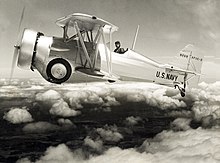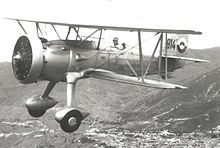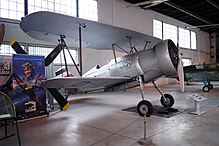| F11C Goshawk | |
|---|---|
 XF11C-2 Goshawk, piloted by Curtiss test pilot William J. Crosswell, pictured during a test flight, 4 November 1932. XF11C-2 Goshawk, piloted by Curtiss test pilot William J. Crosswell, pictured during a test flight, 4 November 1932. | |
| General information | |
| Type | Carrier-based Fighter and fighter-bomber |
| National origin | United States |
| Manufacturer | Curtiss Aeroplane and Motor Company |
| Primary users | United States Navy Chinese Nationalist Air Force Colombian Air Force |
| Number built | 28 plus 2 prototypes |
| History | |
| Manufactured | October 1932 |
| Introduction date | April 1932 |
| First flight | September 1932 |
| Variants | Curtiss BF2C Goshawk |
The Curtiss F11C Goshawk is an American naval biplane fighter aircraft that saw limited success. It was part of a long line of Curtiss Hawk airplanes built by the Curtiss Aeroplane and Motor Company for the American military.
Design and development
In April 1932, when Curtiss was planning the Model 35B, the United States Navy contracted with the manufacturer for an improved derivative of the Model 34C, F6C as the F11C. It contained major changes that included the 600 hp (450 kW) Wright R-1510-98 radial engine, single-leg cantilever main landing-gear units, a slight increase in the interplane gap, metal- rather than fabric-covered control surfaces, and armament based on two .30 in (7.62 mm) fixed forward-firing machine guns supplemented by a hardpoint under the fuselage for the carriage of a 474 lb (215 kg) bomb, or an auxiliary fuel tank. Curtiss designed the type as the Model 64 Goshawk, with the U.S. Navy designation XF11C-1 (later XBFC-1 after the adoption of the BF for Bomber-Fighter category). The aircraft was of fabric-covered metal construction, used the wing cell structure of the dismantled YP-23, and was delivered in September 1932.
Shortly before ordering the XF11C-1, the Navy had bought a company-owned Model 64A demonstrator. This had a Wright R-1820-78 Cyclone engine, slightly longer main landing-gear legs carrying wheels with low-pressure tires, a tailwheel in place of the tailskid, fabric-covered control surfaces on the tail, and external provision for underwing racks for light bombs as well as an under-fuselage hardpoint for either a 50 gal (189 L) fuel tank or the crutch that would swing a bomb clear of the propeller disc before release in a dive-bombing attack.
Flight trials of this XF11C-2 (later redesignated as the XBFC-2) revealed the need for a small number of minor changes. After making the changes, the XF11C-2 came to be regarded as the prototype for the F11C-2, of which 28 examples were ordered as dual-role fighter-bombers in October 1932.
From March 1934, the aircraft were revised with a semi-enclosed cockpit and a number of other modifications before they received the revised designation BFC-2 in recognition of their fighter-bomber or, as the Navy would have it, bomber-fighter role The last aircraft in the XF11C-2 contract was converted to the prototype XF11C-3, incorporating a more powerful R-1820-80 engine and a hand-operated retractable landing gear.


Operational history
The only U.S. Navy units to operate the F11C-2 were the Navy's famous "High Hat Squadron", VF-1B, aboard the carrier Saratoga, and VB-6 briefly assigned to Enterprise. In March 1934, when the aircraft were redesignated BFC-2, the "High Hat Squadron" was renumbered VB-2B, and then VB-3B, and retained its BFC-2s until February 1938. VB-6 never actually embarked on Enterprise with the BFC bombers.

The F11C-2 Goshawk was produced in two export versions as the Hawk I and Hawk II fighters. Essentially a modified XF11C-2, the Hawk II was fitted with a Wright R-1820F-3 Cyclone rated at 710 hp (530 kW) at 1,676 m (5,499 ft) and 356 liters of fuel while the Hawk I had 189 liters of internal fuel. Both versions carried the same armament as the production F11C-2. Only the Hawk II was exported in quantity with Turkey, the first customer taking delivery of 19 on August 30, 1932. Colombia placed an order at the end of October 1932, receiving an initial batch of four twin float-equipped Hawk IIs, the first of a total of 26 float fighters delivered by the end of July 1934. The Colombian Air Force used Hawk II and F11C-2 based in floats in the Colombia-Peru War in 1932-1933. Nine Hawk IIs were supplied to Bolivia, of which three had interchangeable wheel/float undercarriages; four were delivered to Chile, four to Cuba, two to Germany, one to Norway and 12 to Thailand as Hawk IIIs.
The Chinese Nationalist Air Force received 52 F11Cs as Hawk IIs and fought against the Japanese during the Second Sino-Japanese War. Hawk II squadron commander Captain Chan Kee-Wong of the 28th Squadron, 5th Fighter Group based at Chuyung Airbase for the defense of Nanking at the outbreak of the war against the Imperial Japanese invasion, made a partial claim in the shooting-down of a Mitsubishi G3M medium-heavy bomber on 15 August, 1937. He and half of his squadron were soon dispatched to Taiyuan in the northern front of the war in China, and famously shot down Major Hiroshi Miwa (former military flight instructor for Zhang Xueliang's Fengtian Army air corps), commander of the 16th Hiko Rentai, 1st Daitai squadron of Kawasaki Ki-10 fighters during the Battle of Taiyuan It was the main battlefield of the F11C in World War II.
Thai Hawk IIIs saw action during World War II, including against the Royal Air Force. On 8 April 1944, a Thai Hawk III was shot down by a No. 211 Squadron RAF Bristol Beaufighter over Lamphun, the pilot of the downed aircraft escaping by parachute.
Variants
- XF11C-1 (Model 64)
- First prototype derived from the F6C Hawk.
- XF11C-2 (Model 64A)
- Second prototype, redesignated XBFC-2.
- F11C-2 (Model 64A)
- Production version, redesignated BFC-2; 28 built.
- XF11C-3 (Model 67)
- One F11C-2 fitted with retractable undercarriage and a 700 hp (520 kW) R-1820-80, later redesignated XBF2C-1 fighter-bomber.
- BFC-2 Hawk
- Redesignation of F11C-2.
Operators


- Colombian Air Force - Used in the Colombia-Peru War.
- Two aircraft were bought by Germany for evaluation. One of them, D-3165, was tested as a floatplane.
- Royal Norwegian Air Force - One aircraft purchased for evaluation purposes.
- Peruvian Navy - Three float-equipped aircraft were purchased in March 1933. Four additional machines were bought in 1934.
- United States Navy operated 28 aircraft as the squadron VF-1B, flying from the aircraft carrier Saratoga.
Surviving aircraft
During the spring of 1933, Franz Muller who was a senior official in the Reich Air Ministry, informed Göring that he was approached by Udet to seek approval for the purchase of two Goshawks for dive bombing trials. Göring authorized the funds via the German Embassy in Washington DC. In October 1933 the pair of Goshawks arrived in Bremerhaven aboard the liner SS Europa. Udet used one of these Goshawks (designated D-IRIK) in aerobatic exhibitions held during the 1936 Summer Olympics, the aircraft survived the war, was eventually found in a field outside Kraków, now on display in the Polish Aviation Museum.
A BFC-2 is in the National Naval Aviation Museum on NAS Pensacola, Florida.
A Hawk III, the only one existing, has been restored by the Royal Thai Air Force Museum. The aircraft on display is painted with (Hanuman, white body) insignia identifying it as belonging to Wing 4. The Hawk III served in the RTAF between 1934–1949.
Specifications (F11C-2) & (BFC-2)
Data from Curtiss Aircraft 1907–1947, The Complete Encyclopedia of World Aircraft
General characteristics
- Crew: 1
- Length: 22 ft 7 in (6.88 m)
- Wingspan: 31 ft 6 in (9.60 m)
- Height: 9 ft 8.625 in (2.96228 m)
- Wing area: 262 sq ft (24.3 m)
- Airfoil: root: Clark Y; tip: Clark Y
- Empty weight: 3,037 lb (1,378 kg)
- Gross weight: 4,132 lb (1,874 kg)
- Powerplant: × Wright R-1820-78 Cyclone 9-cylinder air-cooled radial piston engine, 600 hp (450 kW)
- Propellers: 3-bladed metal propeller
Performance
- Maximum speed: 202 mph (325 km/h, 176 kn)
- Cruise speed: 150 mph (240 km/h, 130 kn)
- Range: 522 mi (840 km, 454 nmi)
- Service ceiling: 25,100 ft (7,700 m)
- Rate of climb: 2,300 ft/min (12 m/s)
Armament
- Guns: 2x fixed, synchronized .30 in (7.62 mm) AN/M2 Browning machine guns in the forward fuselage
- Bombs:
- 1x 215 kg (474 lb) bomb on an under-fuselage hardpoint or
- 2x 53 kg (117 lb) bombs carried one under each lower wing
Notes
- ^ Eden and Moeng 2002
- "Photograph - 'Photograph of F11C-3 Goshawk aircraft'." Archived 2011-07-27 at the Wayback Machine U.S. Navy Museum (Pensacola), 31 January 2000. Retrieved: 13 May 2009.
- Swanborough and Bowers 1976
- 网易, 丘智贤 (2018-02-02). "广东队长太原击落日本驱逐之王三轮宽". news.163.com. Retrieved 2020-11-16.
1937年9月21日,击落日军著名飞行员三轮宽的我空军第二十八队队长陈其光 (照片) - 支那事变殊勋录刊登之日本陆军航空兵中佐三轮宽 (照片)
- Gustavsson, Hakans. "Chinese biplane fighter aces - Chan Kee-Wong". Biplane Fighter Aces - China. Retrieved 2020-11-16.
Captain Chan found himself all alone facing three IJAAF Ki-10s led by Major Miwa; in what appeared to a challenge to "single combat" - Miwa dove at him from above, Chan countered by pulling his nose up to face Miwa head-on. Anticipating that Miwa would need to pull out of his dive after they pass - Chan pulled into a tight chandelle - into his manoeuvre even before Miwa passed him - Chan was able turn around - above and behind Miwa - taking advantage of his position for a zero-deflection shooting pass, Chan shot up Miwa's Ki-10, sending it crashing into a field near Ta Meng.
- Gustavsson, Håkan. "Curtiss Hawks in the Chinese Air Force". Biplane Fighter Aces from the Second World War. Retrieved 30 January 2013.
- Thomas 2005, pp. 73-74
- Hitler's Stuka Squadrons-The Ju 87 At War 1936-45 by John Ward
- Hitler's Generals: Udet (TV aeries)
- "Aircraft: Curtiss Hawk II". Muzeum Lotnictwa Polskiego. Retrieved 16 April 2023.
- "BFC-2 Goshawk". National Naval Aviation Museum. Archived from the original on 30 August 2016. Retrieved 16 April 2023.
- Trirat. "A Briefer History of the Royal Thai Air Force." Archived 2011-10-02 at the Wayback Machine nationmultimedia.com, October 2007. Retrieved: 30 August 30, 2011.
- Bowers, Peter M. (1979). Curtiss aircraft, 1907-1947. London: Putnam. pp. 274–277. ISBN 0370100298.
- Eden and Moeng 2002, p. 514.
- Lednicer, David. "The Incomplete Guide to Airfoil Usage". m-selig.ae.illinois.edu. Retrieved 16 April 2019.
Bibliography
- Bellomo, Sergio; Cordon Aguirre, Arturo; Marino, Atilio; Núñez Padin, Jorge (1999). Núñez Padin, Jorge Felix (ed.). Curtiss Hawk. Serie Fuerza Aérea Argentina (in Spanish). Vol. 5. Bahía Blanca, Argentina: Fuerzas Aeronavales.
- Eden, Paul and Soph Moeng. The Complete Encyclopedia of World Aircraft. London: Amber Books, 2002. ISBN 978-0-7607-3432-2.
- Hagedorn, Dan (March–May 1992). "Curtiss Types in Latin America". Air Enthusiast. No. 45. pp. 61–77. ISSN 0143-5450.
- Swanborough, Gordon and Peter M. Bowers. United States Military Aircraft Since 1911. Annapolis, Maryland: Naval Institute Press, 1976. ISBN 978-0-87021-968-9.
- Thomas, Andrew (2005). Beaufighter Aces of World War 2. Oxford: Osprey Publishing. ISBN 978-1-84176-846-5.
- Ward, John (2004). Hitler's Stuka Squadrons: The Ju 87 at War 1936-1945. Spellmount. ISBN 1862272468.
- Young, Edward M. (1984). "France's Forgotten Air War". Air Enthusiast. No. 25. pp. 22–33. ISSN 0143-5450.
External links
- Bolivian Curtiss Hawk II
- Curtiss Goshawk Marketing Brochure
- The Curtiss F11C-2 Goshawk Images
- Silhouette of the plane
| USN/USMC bomber designations 1931–1962 | |||||||||||||||
|---|---|---|---|---|---|---|---|---|---|---|---|---|---|---|---|
| Bomber |
| ||||||||||||||
| Bomber Drone |
| ||||||||||||||
| Bomber Fighter |
| ||||||||||||||
| Bomber Torpedo |
| ||||||||||||||
| United States Navy fighter designations pre-1962 | |
|---|---|
| General Aviation Brewster | |
| Boeing | |
| Curtiss | |
| Douglas McDonnell | |
| Grumman | |
| Eberhart Goodyear | |
| Hall McDonnell | |
| Berliner-Joyce North American | |
| Loening Bell | |
| General Motors | |
| Naval Aircraft Factory | |
| Lockheed | |
| Ryan | |
| Supermarine | |
| Northrop | |
| Vought | |
| Canadian Vickers Lockheed | |
| Wright CC&F |
|
| Convair | |
| Not assigned • Assigned to a different manufacturer's type See also: Aeromarine AS • Vought VE-7 | |
| Curtiss and Curtiss-Wright aircraft | |||||||||||||||||||||||||||||||||||||||||||||||||||||||||
|---|---|---|---|---|---|---|---|---|---|---|---|---|---|---|---|---|---|---|---|---|---|---|---|---|---|---|---|---|---|---|---|---|---|---|---|---|---|---|---|---|---|---|---|---|---|---|---|---|---|---|---|---|---|---|---|---|---|
| Manufacturer designations |
| ||||||||||||||||||||||||||||||||||||||||||||||||||||||||
| Operator and role |
| ||||||||||||||||||||||||||||||||||||||||||||||||||||||||
| Designation skipped Not built | |||||||||||||||||||||||||||||||||||||||||||||||||||||||||
| Royal Thai Armed Forces fighter designations | |
|---|---|
| B.Kh (Fighter) | |
| Related designations | |